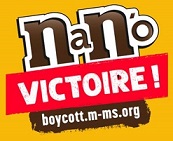|
Agir Pour l' Environnement(環境への取り組み連合)
2018年11月22日 ボイコットで脅されてマース社はついに 製品ブランド M&M's からナノを取り下げる 情報源:Agir Pour l' Environnement, November 22, 2018 THREATENED BY A BOYCOTT, MARS FINALLY ACCEPTS TO WITHDRAW NANOS FROM THE M&M's BY MID-2019 https://boycott.m-ms.org/victoire-mms 訳:安間 武 (化学物質問題市民研究会) http://www.ne.jp/asahi/kagaku/pico/ 掲載日:2018年12月7日 このページへのリンク: http://www.ne.jp/asahi/kagaku/pico/nano/ngo/181122_Agir_Pour_Env_ MARS_finally_accept_to_withdraw_nanos_by_mid_2019.html
Agir Pour l' Environnement(環境への取り組み連合)は、マース社がこの決定をしたことを喜んでいる。同社は、最終的には期限近くに約束した。しかし Agir Pour l' Environnement は、同社が顧客の健康を気にかけるのにそのように長い時間がかかったこと、そして同社が食品情報の顧客への提供に関する欧州連合の規則に違反した行動をまだとっていることを残念に思う。 この約束は、他の NGOs やジョゼ・ボヴェのような有名人によって2015年以来行われてきた同社に対する定例の抗議の後、来るべきボイコットの予告後一週間以内に発表された。そのことは市民の結集がこの巨大食品加工会社の戦略にある影響を及ぼすことができることを示している。この一週間内で約1万人の消費者らが、ウェブサイト boycott.m-ms.org の呼びかけに応じて M&M's ブランド製品ボイコットの示威行動をした。 抗議団代表のステファン・ケルコフによれば、”マース社は、市場の主要な動向は、危険な化学物質であるナノ粒子を含有するかもしれないすべての添加物を取り除くことであることを最終的に理解した。消費者が科学的テストに供されるべきではない!”。この二年間、フランスの多くの事業者、すなわち Carambar&co, Lutti, Verquin...などの菓子製造者だけでなく、小売業者(Carrefour, Casino Systeme U...)などがが二酸化チタンの使用を中止した。 小さくても(Mini Size) 大きな(Maxi)なリスク 世界中で最も売れているこの菓子(年 2,000億 の M&M's ブランド製品)は、製品を白色化/不透明化する色素添加物二酸化チタンを含んでいる。独立系の分析は、それがナノスケールでも存在することを示している。”ナノ粒子は極めて微小な粒子で(塩粒より1万倍小さい)、新規であるのみならずな制御できない特性をもつ。ある科学者らはアスベストに例えるこれらの粒子は容易に人間の体内に侵入し蓄積して有害影響:がん性病変、炎症、免疫系の低下などをもたらす。 フランス当局の様子見の態度 フランス競争・消費・不正抑止総局(DGCCRF)は、消費者への食品情報提供に関する欧州連合の規制を施行するのに、なぜそのように時間がかかるのか? 政府は 2018年10月に施行された農業・食品法の第53条に従い、食品中の二酸化チタン粒子の懸濁についての法令を、なぜ定めなかったのか? 法律だけが頑固な製造者らを強制することができる。モンデリーズ(ルー・ビスケット、ハリウッド・チューインガム、スティモロル、ミルカ、マックスウェル・コーヒ)、ヴァイネ(パティスリー・オーナメント)、ファション、カルト・ドール。大事なことをひとつ言い残したが、ナノ粒子は、固化防止剤 E551 のような他の添加物、化粧品(日焼け止め、歯磨き、口紅…)のようなその他の製品、そして医薬品の中に隠されている。 (訳注) 本キャンペーンのウェブサイトはフランス語ですが、キャンペーン主催者の Agir Pour l' Environnement(環境への取り組み連合)が下記に示す英文テキストを発表しているので、この英文テキストに基づき、日本語訳しました。
訳注1 マース(M&M's)ピーナッツ 訳注:二酸化チタン着色剤 E171 関連情報
|
